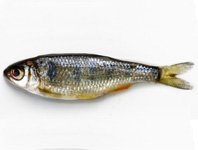Abstract
Schindler’s fishes (Schindleria) are extremely paedomorphic and only a few morphological characters are suitable for species delimitation of these tiny fishes. Three of these key morphological characters, the (i) origin of the dorsal fin relative to the anal fin, (ii) number of vertebrae and (iii) coloration, need reinterpretation in a recently described species, Schindleria nigropunctata. To avoid nomenclatorial problems S. nigropunctata is redescribed from the type material. This species is characterized by 16–17 dorsal fin rays, 16 pectoral fin rays, origin of the anal fin ventral to the 8th dorsal fin ray, 37–38 myomeres, a uniform greyish-white colored body (preserved) and a trunk without obvious pigmentation (no black pigment spots). The eyes are dark grey with a silvery cornea. Dorsally on the cornea are blackish melanophores arranged in a sickle-shaped pattern.
References
Ahnelt, H. & Sauberer M (2018) A new species of Schindler fish (Teleostei: Gobiidae: Schindleria) from the Malaya Archipelago (Southeast Asia), with notes on the caudal fin complex of Schindleria. Zootaxa, 4531, 95–108.
https://doi.org/10.11646/zootaxa.4531.1.4
Betancur-R, R., Wiley, E.O., Arratia, G., Acero, A., Bailly, N., Miya, M., Lecointre, G. & Orti, G. (2017) Phylogenetic classification of bony fishes. BMC Evolutionary Biology, 17, 162.
Collin, S.P. & Collin, H.B. (2001) The fish cornea: adaptation for different aquatic environments. In: Kapoor, B.G. & Hara, T. (Eds), Sensory biology of jawed fishes. New insights. Enfield (NH), USA, Science Publishers Inc., pp. 57–96.
Fricke, R. & El-Regal, A.M.A. (2017a) Schindleria nigropunctata, a new species of paedomorphic gobioid fish from the Red Sea (Teleostei: Schindleriidae). Marine Biodiversity.
https://doi.org/10.1007/s12526-017-0831-z
Fricke, R. & El-Regal, A.M.A. (2017b) Schindleria elongata, a new species of paedomorphic gobioid from the Red Sea (Teleostei: Schindleriidae). Journal of Fish Biology, 90, 1883–1890.
Gill, A.C. & Mooi, R.D. (2010) Evidence for the monophyly of the Microdesmidae, with comments on relationships to Schindleria (Teleostei: Gobioidei: Gobiidae). Zootaxa 2442, 51–59.
Golani, D. & Fricke, R. (2018) Checklist of the Red Sea Fishes with delineation of the Gulf of Suez, Gulf of Aqaba, endemism and Lessepsian migrants. Zootaxa, 4509, 1–215. Harris, S.A. & Cyrus, D.P. (1996) Occurrence of Schindler’s fishes, genus Schindleria (Teleostei: Gobioidei), at a small reef in the mouth of the Kosi estuary, Kwazulu-Natal: a first record for southern Africa. Bulletin of Marine Science, 59, 228–234. Johnson, G.D. & Brothers, E.B. (1993) Schindleria: a paedomorphic goby (Teleostei: Gobioidei). Bulletin of Marine Science, 52, 441–471.
Jones, S. & Kumaran, M. (1964) The occurrence of fishes of the family Schindleriidae in the Indian Ocean. Current Science, 33, 145.
Kon, T. & Yoshino, T. (2002) Extremely early maturity found in Okinawan gobioid fishes. Ichthyological Research, 49, 224–228.
Kon, T., Yoshino, T., Mukai, T. & Nishida M. (2007). DNA sequences identify numerous cryptic species of the vertebrate: A lesson from the gobioid fish Schindleria. Molecular Phylogenetics and Evolution, 44, 53–62.
Kon, T., Yoshino, T. & Nishida, M. (2011) Cryptic species of the gobioid paedomorphic genus Schindleria from Palau, western Pacific Ocean. Ichthyological Research, 58, 62–66.
Landaeta, M.F., Veas, R. & Castro, L.R. (2002) First record of the paedomorphic goby Schindleria praematura, Ester Island, South Pacific. Journal of Fish Biology, 61, 289–292.
Orlov, O.Y. & Kondrashev, S.L. (1998) Changeable coloration of cornea in fishes and its distribution. Jugoslavic Physiology and Pharmacology Acta, 34, 359–369.
Sardou, J. (1974) Contribution a la connaissance de la faune ichthyologique Malagache: Découverte de poissons de la famille des Schindleriidae dans le canal de Mozambique, à Nosy-Béet étude d’une collection de Schindleria. Cahier O.R.S.T.O.M., serie Oceanographie, 12, 2–15.
Schindler, O. (1930) Ein neuer Hemirhamphus aus dem Pazifischen Ozean. Anzeiger der Akademie der Wissenschaften Wien, 67, 79–80.
Schindler, O. (1931) Ein neuer Hemirhamphus aus dem Pazifischen Ozean. Anzeiger der Akademie der Wissenschaften Wien, 68, 2–3.
Schindler, O. (1932) Sexually mature larval Hemiramphidae from the Hawaiian Islands. Bulletin of the Bernice P. Bishop Museum, 97, 1–28.
Thacker, C.E. (2009) Phylogeny of Gobioidei and placement within Acanthomorpha, with a new classification and investigation of di- versification and character evolution. Copeia, 2009, 93–104.
Watson, W. (1989) Schindleriidae – Schindler’s fishes. In: Leis, J.M. & Trnski, T. (Eds.), The larvae of Indo-Pacific shore fishes. University of Hawaii Press, Honolulu, pp. 270–273.
Watson, W. & Walker, H.J. (2004) The world’s smallest vertebrate, Schindleria bervipinguis, a new paedomorphic species in the family Schindleriidae (Perciformes: Gobioidei). Record of the Australian Museum, 56, 139–142.

